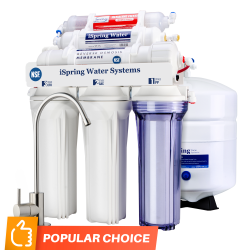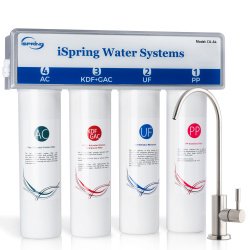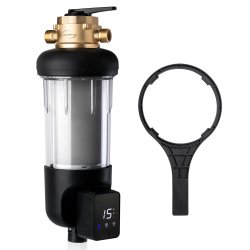
In an ideal world, enjoying pure, healthy water would be as simple as turning on the faucet. However, we know that there are often water contaminants lurking in our drinking water. While some are harmless, others can pose health issues and need to be addressed. Unfortunately, it is not as simple as installing a water filtration system. To effectively combat the contaminants of concern in your water, you have to tackle them with the proper filter.
Key Points
- Understanding what contaminants are commonly present in water and what filter is able to effectively remove them
- What micron ratings are and why they matter when selecting your filter
- Recommended iSpring systems to address your unique water concerns
What’s In Your Water?
Contaminants such as spores, pollen, lint, sand, and other sediment are often large enough to be detected at a glance. In this case, it is quite obvious that a water filtration system is necessary.
However, your water may appear to be crystal clear and contaminant-free since many water contaminants such as viruses, bacteria, insecticides, and industrial gases are less than 20 microns, which are too small to be seen by the naked eye. This can provide people with a false sense of confidence in their water.
Understanding your water’s unique composition and the concerns you want to address with your filtration system will enable you to select the correct system.
Contaminant size in microns
Contaminant Size (microns)
Viruses 0.003 - 0.05
Bacteria 0.03 - 30
Spores 10 - 40
Pollen 10 - 100
Lint 0 - 100
Insecticides 1 - 10
Dust in buildings 0.01 - 20
Fumes 0.001 - 0.1
Industrial gases 0.2 - 0.4
Aerosols 0.005 - 5
Cement dust 4 - 100
Sand 100 - 1000
Soot 0.01 - 0.15
Lung damaging dust 0.14 - 1.6
Tobacco smoke 0.01 - 1
Human hair 30 - 120
Water Filtration Systems are Not Created Equally
Just as the human eye has limitations on what it can see, different filters have limitations on what they can remove. Different filters are specifically designed to remove certain types and sizes of contaminants.
When looking at filters, you will notice that each one comes with a micron filtration rating. This rating tells you what size particles the filter is able to remove. Filters that carry a higher micron rating (5) remove larger particles, while lower ratings (0.5-1) capture smaller particles.
Many assume, that the finer, the better. However, that is not necessarily the case. The optimal micron level for your water filter will be determined by what you are trying to achieve.
If you try to use too fine of a water filter and have large particles in your water, then your filter will quickly become clogged and ineffective. On the other hand, if you try to use too large of a micron filter, then what you may be trying to remove from your water may be effortlessly allowed to pass through the filter and remain.
Because of this, it is necessary to select your filter based on your water’s unique composition and your concerns. Since a single water filter alone cannot address an array of concerns, it may be necessary to have multiple stages of filtration to address a variety of concerns and to provide you with the highest quality water possible.
For example, it might be necessary to have a sediment filter remove larger particles before having your water pass through a reverse osmosis (RO) membrane to filter out the finer impurities and then finally have it polished off with an activated carbon filter to provide tastier water.
Common Filters in the World of Water Filtration
Taking into account what the different micron levels achieve, below are the common filters that are included in a water filtration system. Not only do they work to remove impurities of different sizes, but they also function differently to remove different types of contaminants.
- Spin Down Sediment Filters remove larger particles such as dirt, sand, and rust between 50 - 1000 microns before they reach larger filters or appliances.
- PP Sediment Filters remove smaller particles, up to 5 microns, such as sediments, dust, sand, large particles, silt, dirt, and rust.
- CTO Carbon Filter is also rated at 5 microns and reduces fine sediment and chlorine taste and odor in residential and commercial drinking water.
- A GAC Carbon Filter is another filter rated at 5 microns. It works to remove chlorine, chloramine, PFAS, bad odors, and taste.
- A UF(Ultra-Filtration) Membrane is rated at 0.01 microns and removes infectious microbes such as bacteria, protozoan, and algae.
- A RO (Reverse Osmosis) membrane is rated at 0.0001 microns and removes up to 99% of over 1,000 contaminants including lead, chlorine, fluoride, arsenic, asbestos, calcium, sodium, and more.
iSpring’s Solutions for Your Unique Needs
Taking into account the wide range of consumers’ concerns, iSpring offers a variety of filters to meet these unique needs.
Our WSP50ARJ-BP whole house prefilter is specifically designed to remove large sediment; our
CU-A4 is a UF filtration system that removes essentially all colloidal particles including PFAS, chlorine and chlorine treatment by-products, lead, and much more; and our RCC7AK is a reverse osmosis system that removes dissolved solids and over 1,000 harmful contaminants.
Our WSP50ARJ-BP is a reliable first line of defense used to protect household appliances and terminal equipment by filtering out up to 99% of large particles such as sediments, dirt, rust, sand, floating objects, and other water pollutants. This system allows the customer to select between four different micron screen sizes to meet their unique needs: 50 microns, 100 microns, 200 microns, and 500 microns Additionally, this filter
- comes equipped with a built-in auto flushing module featuring dual power supply options, simplifying routine maintenance.
- provides 4 different operation modes, including filtration mode, shut-off mode, bypass mode, and backwash mode.
- is designed for a more complicated well water situation by providing a 1-gallon capacity, which is 22 times larger than standard sediment filters.
- is crafted from 316L food-grade stainless steel and employs a precision filter mesh to ensure exceptional durability.
If smaller impurities are of concern to you, our CU-A4 water filtration system uses four stages to purify your water. Its first stage PP Sediment Filter is rated at 5 microns and is able to remove larger particles like rust, sand, and dirt. Its second-stage Ultra Filtration Filter is rated at 0.01 microns and works with the third-stage KDF and Activated Carbon Compound filter to remove up to 99% of PFAS, chlorine, and chlorine treatment by-products, lead, and much more while retaining minerals. However, it does not lower TDS as our reverse osmosis (RO) systems do. Its fourth stage Post Activated Carbon Filter provides a final polishing. Additionally, this filter
- conveniently fits under your sink and produces no waste water and does not require a water tank, making it a highly effective water filtration for any number of clean water needs.
- features twist filter cartridges, which makes changing filters effortless.
- comes with a premium brushed nickel drinking water faucet and strictly complies with NSF/ANSI standards for safety and water quality.
- is equipped with push-to-connect fittings with color-coded tubing to simplify the installation process.
Our RCC7AK is a reverse osmosis (RO) system designed to remove contaminants down to 0.0001 microns while restoring the natural alkalinity and mineral balance of water with its 6-stage filtration system. Additionally, this filter
- is NSF/ANSI 58 certified
- employs a second-stage GAC filter and a third-stage carbon block filter to effectively eliminate chlorine, unpleasant tastes, odors, cloudiness, and sediment
- uses a pressurized tank to ensure a stable water flow
- produces up to 75 gallons of filtered water per day
- can be connected directly to the refrigerator’s water supply



